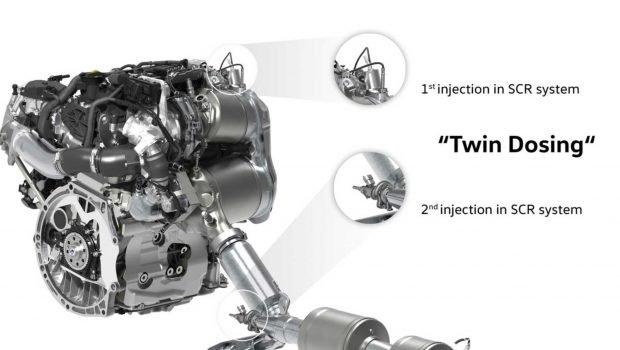Volkswagen Mencuba Sekali Lagi Dengan Power Diesel Mereka
Selepas penipuan badan pengawalseliaan dan berpuluh-puluh ribu pelanggan di seluruh dunia semasa bencana diesegatel, Volkswagen kembali dan meminta peluang ke-2. Syarikat itu mengeluarkan maklumat baharu mengenai enjin diesel EA 288 mereka. EA 288 EVO menggunakan teknologi Twin Dosing, yang melibatkan tiga penukar katalitik, penapis zarah dan ammonia untuk mengurangkan pelepasan NOX sebanyak 80%.
Berikut adalah video bagaimana ia berfungsi dan kenyataan mereka:
The catalytic converters and the particulate filter are the key components in the purification of diesel exhaust gases. The catalytic converters work best in a certain temperature range. The EA 288 Evo actually features three catalytic converters – an oxidising catalytic converter fitted directly to the engine, and the first SCR catalytic converter inside a component with the diesel particulate filter directly behind it. The second SCR catalytic converter is located in the underbody of the vehicle. Since the distance to the engine is greater, the exhaust gas temperature upstream of the second catalytic converter can be as much as 100oC lower. As a result, one of the catalytic converters is always operating in the optimum temperature range, depending on the vehicle operating mode, to facilitate extra-efficient exhaust gas aftertreatment.
Ammonia is needed to reduce harmful nitrogen oxides. A metering module injects the substance into the exhaust gas upstream of the relevant SCR catalytic converter as AdBlue. Here, the solution evaporates and the reducing agent (urea) is broken down, combining with steam to form ammonia. In the catalytic converter, the ammonia then reacts with the nitrogen oxides on a special coating to form water and harmless nitrogen.
The special feature here is that the twin dosing process is effective at almost all temperatures owing to the two catalytic converters. The first SCR catalytic converter nearest the engine warms up quickly so begins to work quickly once the engine is started and it reaches peak performance when the vehicle is in motion and operating at low loads, while the catalytic converter in the underbody comes into its own when the car is operating at high loads – for instance on motorways or when towing a trailer. The increased efficiency of the dosing process means that AdBlue consumption remains at the same level despite being injected twice.
Uncompromising driving dynamics
The twin dosing process not only maintains smooth running, long range and powerful torque – the three key reasons for buying a diesel vehicle, in addition to fuel consumption – but also enhances these features through the use of ultra-modern engine technology. This gives more driving pleasure with less consumption and lower emissions.
Current RDE (real driving emissions) measurements from independent institutes confirm that, in the new 2.0 TDI Evo engines with twin dosing, NOX levels are reduced by around 80% compared with the previous generation of the respective models – well below the limits of the Euro 6d emissions standard.
The RDE measurements are considered to be particularly conclusive because they are taken while the vehicle is actually moving and not on a rolling road test bed with reproducible results as is usually the case.
Markus Köhne, Head of Diesel Engine Development at Volkswagen, explains: “the innovative twin dosing technology we have developed means that our diesel engines are significantly below current limits and are in fact also well below the future limits required under the Euro 6d emissions standard in many measurements conducted by independent institutes. Our diesel engines are therefore not only extremely efficient, powerful and generate a high torque – they also contribute to a cleaner environment. We are extremely proud of this.”






No Comment